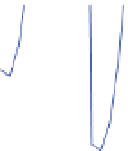Geoscience Reference
In-Depth Information
Plot of misit − E2:1809.5 s
Minimum misit = 1.03 Position = 42 of 360 elements
1.25
1.2
1.15
1.1
1.05
X
:12
Y
: 1.048
1
0.95
0.9
30
40
50
60
70
10
20
Modeled dipole position
Figure 5.29
Zoom in misfit for all the observations of the genetic algorithm search algorithm of Event E2. This figure shows that there
are dipole positions that are close to the minimum of the misfit function, which is shown by the small open circles. The position
marked by
x
= 12 represents another possible location that is only slightly greater than the minimum found at 42. There are other points
that are spatially adjacent to 42, including 11, and 41. (
See insert for color representation of the figure
.)
yield equivalent or better results if more than one
dipole is considered in the inversion process (see earlier
comments about the point matrix positioning for Event
E2). Figure 5.30 shows the forward modeled results with
Dipole #42 only. The position of Dipole #42 is located at
210 from the right side, on the second ring. The moment
of the dipole (Figure 5.30e and f) generates a spatial
distribution of the voltage that is tipped in a similar
manner to the real data shown in Figure 5.20a and b. This
orientation of the dipole implies that the axis of fluid flow
is likely flowing mostly upward along the hole annulus
with a slight flow direction away from the hole. This
may be due to the way the epoxy is blocking the flow,
causing a diversion of the flow away fromHole 9, or there
could be a component of flow into the cement block
(Darcy flow or microcracks).
Figure 5.31 shows the results of the GA single dipole
search for Event E3. The misfit for this event shows a
minimum at position 47 (Dipole #47) with a significant
departure from the minimum as the dipole positions
increase away from this position. There are some other
dipoles that come close to the minimum; these dipoles
are all spatially very close to Dipole #47 and at positions
17, 18, 48, 77, and 78 (see earlier comments about the
point matrix positioning for Event E2) (Figure 5.32).
The spatial voltage distribution of the inversion also
shows a slight tilt on the back array that is similar to
the tip shown in Figures 5.19, 5.20c and d. This GA-based
inversion places the event E3 dipole higher in the block
than the dipole of Event E2, with an orientation of the
dipole moment that indicates the fluid flow axis is mostly
upward along the hole with a slight tipping toward a
tangent-like trajectory along the hole. It should also be
noted that Dipole #47 is in a position that is directly above
the Dipole #42 position, indicating that the flow between
Events E2 and E3 is likely to be mostly vertical. It should
be clarified here that the other impulses in the data may
localize to somewhat different points along the hole
and may show other shifting of the flow pathway, and
therefore, great care should be used to not overinterpret
the results of the inversion (Figure 5.33). Because of the
still relatively coarse resolution of this finer point spread
and the nonadjacency of the selected time slices, the
subtleties of the fluid flow along the annulus of the hole
cannot be resolved from this analysis. However, the
dipole moments of these events may indicate unresolved
fluid flow complexity. The single dipole inversion using
the GA reproduces a similar degree of fit as the thre-
sholded gradient inversion. Analysis of the position data
from the two inversions shows a high degree of
consistency, with all of the GA located point coordinates
falling inside the range of ±1/2 point spacing of the coarse
dipole point matrix.
Figure 5.34 shows, in a notional conceptualization,
how the fluid moved up along the Hole 9 annulus,
breaking through numerous epoxy barriers, and in the
process making direct contact with the cement block
borehole wall. The electrical and pressure data supports
this multiple-chamber, fluid movement concept invol-
ving plastically breached epoxy barriers as shown in
Figure 5.34e. Figure 5.34a through d show the results
of the GA inversion process in the same figure with Event















































